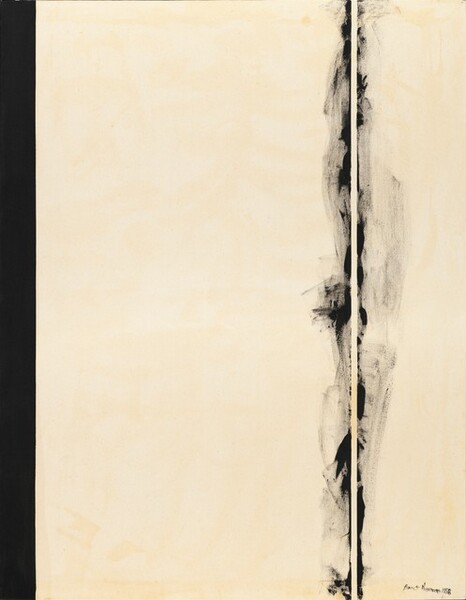

“Your objections? All right! I know them! Of course! We know just what our beautiful false intelligence affirms: `We are only the sum and the prolongation of our ancestors,' it says. Perhaps! All right! What does it matter? But we will not listen! Take care not to repeat those infamous words! Instead, lift up your head!”
Barnett Newman's Stations of the Cross are a series of 14 paintings defined by no clear evolution or progress maintained between them. His iconic zips located at the left and center-right of the canvas appear as the only constant structure between each of the 14 pieces, creating an uneasy sense of connection between each of the works. The installation is meant to be experienced as a pilgrimage, starting here at the first station, and slowly progressing through the room by reflecting at each station.<>
The disjointed nature of the progression between the paintings is at contest with the subject matter at hand. A typically strongly-structured narrative such as the Stations of the Cross in a traditional Religious setting is cast aside here in favor of a less natural evolution form, where the colors ebb and flow, and each stop along the pilgrimage is distinct, but the chronological order is lost on the viewer. In fact, the final order of the installation by Barnett was not set until after the installation of the art. Thus, when evaluation the central question of the work, "Why have you Forsaken Me?", there is not concrete moment in time, nor in space within the gallery, where one can distinguish the "breaking point"; each moment in time, each canvas in the installation, is unique in its existence and it is only as a whole one can see the loss of form.
The intermediate pieces of the installation are not included here, however in their place will be various stages of the Futurist movement as prescribed in the Manifesto by Marinetti. The art, as with Barnett's canvases, may not be in chronological order and may not naturally lead into the next. However, each will be evaluated according to the classical narrative of the stations.
Taken together as a whole, we will find that the tenets laid out within the formation of the movement inevitably led to its demise, however there is no clear moment in time where the perversion took grip. It is only as a whole, looking back at the series, one can witness the destructive philosophy of the Futurist movement and its effects it had on both its advocates as well as those who stood in the way of its perpetual stampede of progress. This march's desmise is built upon the penultimate passage in the manifesto, printed above. The founding philosphy rejects self-reflection and criticism, dismantaling any structure by which to slow the movement. The radical adoption of progress for progress's sake begins the unstoppable rout of tradition and harmony, jsut as the bearing of the cross begins the narritive demise of the Stations.